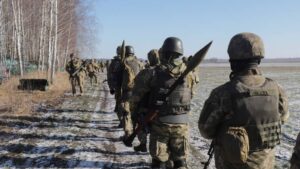Stephanie Savell
I’m co-director of the Costs of War Project at Brown University’s Watson Institute for International and Public Affairs, founded by Catherine Lutz and Neta Crawford in 2011, on the 10th anniversary of the invasion of Afghanistan. Their goal: to draw attention to the hidden and unacknowledged costs of our counterterror wars in Afghanistan, Iraq, and a number of other countries as well.
When I go to dinner parties or take my toddler to play dates and tell my peers what I do for a living, I’ve grown used to the blank stares and vaguely approving comments (“that’s cool”) as we quickly move on to other topics. People do tend to humour me if I begin to speak passionately about the startlingly global reach of this country’s military counterterrorism activities or the massive war debt we’re so thoughtlessly piling up for our children to pay off. I don’t mean to suggest that no one cares about America’s never-ending wars, just that, 17 years after the war on terror began, it’s a topic that seems to fire relatively few of us up, much less send us into the streets, Vietnam-style, to protest. The fact is that those wars are approaching the end of their second decade and yet most of us don’t even think of ourselves as “at war.”
Numbers to Boggle the Mind
In such a climate of disengagement, I’ve learned what can get at least some media attention. Top of the list: mind-boggling numbers. In a counterpoint to the relatively limited estimates issued by the Pentagon, the Costs of War Project has, for instance, come up with a comprehensive estimate of what the war on terror has actually cost this country since 2001: $5.6 trillion. It’s an almost unfathomably large number. Imagine, though, if we had invested such funds in more cancer research or the rebuilding of America’s infrastructure.
That $5.6 trillion includes the costs of caring for post-9/11 veterans as well as spending to prevent terrorist attacks on US soil (“homeland security”). That figure and its annual updates do make the news in places like the Wall Street Journal and the Atlantic magazine and are regularly cited by reporters. Even President Trump, we suspect, has absorbed and, in his typical fashion, inflated our work in his comment at the end of last year that the US has “foolishly spent $7 trillion in the Middle East”.
The media also commonly draws on another set of striking figures we issue: our calculations of deaths, both American and foreign, in Afghanistan, Pakistan, and Iraq. As of 2016, about 14,000 American soldiers and contractors and 380,000 inhabitants of those countries had been killed. To these estimates, you have to add the deaths of at least 800,000 more Afghans, Iraqis, and Pakistanis from indirect causes related to the devastation caused by those wars, including malnutrition, disease, and environmental degradation.
Once you get past the shocking numbers, however, it becomes far harder to get media (or anyone else’s) attention for America’s wars. Certainly, the human and political costs in distant lands are of remarkably little interest here. Today, it’s difficult to imagine a devastating war photo making the front page of a mainstream newspaper, much less galvanising protest, as several now-iconic images did during the Vietnam era.
In August, for instance, the Costs of War Project issued a report that revealed the extent to which immigrant workers in the war zones of Iraq and Afghanistan are exploited. From countries like Nepal, Colombia, and the Philippines, they work for the US military and its private contractors doing jobs like cooking, cleaning, and acting as security guards. Our report documented the kinds of servitude and the range of human rights abuses they regularly face. Often, immigrants are stuck there, living in dangerous and squalid conditions, earning far less than they were promised when recruited, and with no recourse to or protection from the American military, civilian officials, or their home governments.
Our report’s revelations were, I thought, dramatic, largely unknown to the American public, and another reason to demand a conclusion to our never-ending wars in Afghanistan and Iraq. They were also a significant black mark against the private contracting companies that, for years now, have profited so greatly from those wars. Nonetheless, the report got next to no coverage, as has often been the case when it comes to human suffering in those war zones (at least when the sufferers are not US soldiers).
Do Americans really not care? That, at least, seems to have been the judgment of the many journalists who received our press release about the report.
In truth, this has become something like a fact of life in America today, one that’s only been made more extreme by the media’s full-time fascination with President Donald Trump—from his tweets to his insults to his ever-wilder statements. He—or rather the media obsession with his every twitch—poses just the latest challenge to getting attention of any sort for the true costs to us (and everyone else) of our country’s wars.
War to the Horizon and a Demobilised Public and Congress
And so we continue to face a grim reality of this 21st century moment, one that long preceded the presidency of Donald Trump: the lack of connection between the American public and the wars being fought in our names in distant lands. Not surprisingly, this goes hand-in-hand with another reality: you have to be a total war jockey, someone who follows what’s happening more or less full time, to have a shot at knowing what’s really going on in the conflicts that now extend from Pakistan into the heart of Africa.
After all, in this era, secrecy is the essence of the world of Washington, invariably invoked in the name of American “security.” As a researcher on the subject, I repeatedly confront the murkiness of government information about the war on terror. Recently, for instance, we released a project I had worked on for several months: a map of all the places where, in one fashion or another, the US military is now taking some sort of action against terrorism—a staggering 76 nations, or 40% of the countries on the planet.
Of course, it’s hardly surprising these days that our government is far from transparent about so many things, but doing original research on the war on terror has brought this into stark relief for me. I was stunned at how difficult it can be to find the most basic information, scattered at so many different websites, often hidden, sometimes impossible to locate. One obscure but key source for the map we did, for example, proved to be a Pentagon list labeled “Global War on Terrorism Expeditionary Medals Approved Areas of Eligibility.” From it, my team and I were able to learn of places like Ethiopia and Greece that the military deems part of that “War on Terrorism.” We were then able to crosscheck these with the State Department’s “Country Reports on Terrorism,” which officially document terrorist incidents, country by country, and what each country’s government is doing to counter terrorism.
This research process brought home to me that the detachment many Americans feel in relation to those post-9/11 wars is matched—even fed—by the opacity of government information about them. This no doubt stems, at least in part, from a cultural trend: the demobilisation of the American people. The government demands nothing of the public, not even minimalist acts like buying war bonds (as in World War II), which would not only help offset the country’s growing debt from its war-making, but might also generate actual concern and interest in those wars. (Even if the government didn’t spend another dollar on its wars, our research shows that we will still have to pay a breathtaking $8 trillion extra in interest on past war borrowing by the 2050s.)
Our map of the war on terror did, in fact, get some media attention, but as is so often the case when we reach out to even theoretically sympathetic congressional representatives, we heard nothing back from our outreach. Not a peep. That’s hardly surprising, of course, since like the American people, Congress has largely been demobilised when it comes to America’s wars (though not when it comes to pouring ever more federal dollars into the US military).
Last October, when news came out about four Green Berets killed by an Islamic State affiliate in the West African nation of Niger, congressional debates revealed that American lawmakers had little idea where in the world our troops were stationed, what they were doing there, or even the extent of counterterrorism activity among the Pentagon’s various commands. Yet the majority of those representatives remain all too quick to grant blank checks to President Trump’s requests for ever greater military spending (as was also true of requests from presidents Bush and Obama).
After visiting some congressional offices in November, my colleagues and I were struck that even the most progressive among them were talking only about allocating slightly—and I mean slightly—less money to the Pentagon budget, or supporting slightly fewer of the hundreds of military bases with which Washington garrisons the globe. The idea that it might be possible to work toward ending this country’s “forever wars” was essentially unmentionable.
Such a conversation could only come about if Americans—particularly young Americans—were to become passionate about stopping the spread of the war on terror, now considered little short of a “generational struggle” by the US military. For any of this to change, President Trump’s enthusiastic support for expanding the military and its budget, and the fear-based inertia that leads lawmakers to unquestioningly support any American military campaign, would have to be met by a strong counterforce. Through the engagement of significant numbers of concerned citizens, the status quo of war making might be reversed, and the rising tide of the US counterterror wars stemmed.
Toward that end, the Costs of War Project will continue to tell whoever will listen what the longest war(s) in US history are costing Americans and others around the world.
(Stephanie Savell is an anthropologist and co-director of the Costs of War Project at Brown University’s Watson Institute for International and Public Affairs.)




